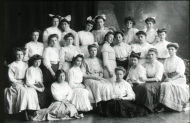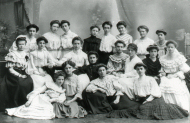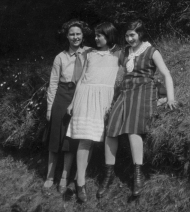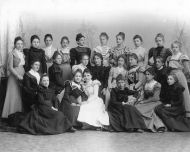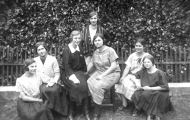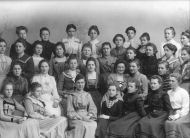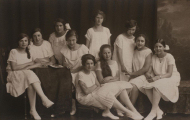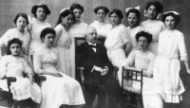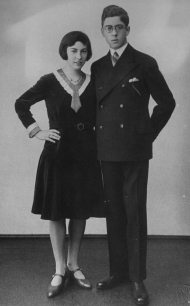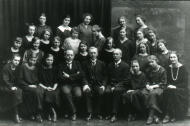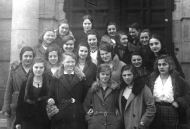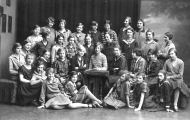|
|
|
|
|
|
|
|
|
|
|
|
|
|
|
|
|
|
|
|
|
|
|
|
|
|
|
|
|
|
|
|
|
|
|
|
|
|
|
|
|
|
|
|
|
|
|
|
|
|
|
|
|
|
|
|
|
|
|
|
|
|
|
|
|
|
|
|
|
|
|
|
|
|
|
|
|
|
|
|
|
|
|
|
|
|
|
|
|
|
|
|
|
|
|
|
|
|
|
|
|
|
|
|||||||||||||||||||||||||||||||||||||||||||||||||||||||||||||||||||
|
Emmy Hecht Born: 1892 in Nuremberg. Father’s occupation: factory owner in Nuremberg. Emmy’s parents were Gustav Hecht (b. 1854) and Frieda, née Heilbronner (b. 1862). Emmy attended the “Municipal School for Daughters” (“Städtische Töchterschule”), which later was to be called “Maria-Theresia-School”, from 1906 to 1908 in classes 4 and 5; the fifth class was the school-leaving class in those times. Emmy married Sigmund Hecht (b. 1884). The married couple emigrated to the USA. Emmy died in New York in 1970. Emmy’s older sister, Irma (b. 1885), worked as a private tutor for Latin and Greek and as a tutorial assistant in Munich. She was deported from Munich to Kovno, Lithuania, on November 20, 1941; the deported men, women and children were shot in Kovno five days later. Source: Andreas Heusler, Brigitte Schmidt, Eva Ohlen, Tobias Weger, and Simone Dicke, Biographisches Gedenkbuch der Münchner Juden 1933–1945, vol. 1 (A–L), ed. Munich City Archives (“Stadtarchiv München”), Munich, 2003, p. 541 (on Irma Hecht). |
|
Emma Heilbronner Born: 1888 in Munich. Father’s occupation: businessman in Munich. Emma (“Emmi”) Heilbronner attended the “Municipal School for Daughters” (“Städtische Töchterschule”), which later was to be called “Maria-Theresia-School”, for only one year, 1904/05, in class 5; this class was the school-leaving class in those times. Emmi’s father was already dead at that time. After graduating at another secondary school (“Lyzeum”), Emmi studied languages, journalism and history of arts at the university. She made educational trips to several European countries. She married Dr. Arthur Lesser (b. 1888). The couple got divorced in 1915. From 1935 to January 1941, Emmi rented rooms at her apartment, 31 / I Elisabethstraße, Munich. Then she moved to 3 Seestraße. On April 1, 1942, Emmi had to present herself at a camp made of huts on Knorrstraße. On April 4, she was deported to Piaski, Poland, and is considered as missing. For two months, from April to June 1942, the engineer Arnold Hindls from Brno, Moravia, also lived in Piaski. For him this was but one of many deportation stations, between Terezin and Ossovo. In his memoirs, One Man Returned, published in Germany in 1965, he tells about Piaski: “Piaski is a small town in the Lublin district, surrounded by sand, swamps, and forests. The state road from Lublin to Chelm divides it into two parts. Therefore, the Jewish ghetto, which once was very large and inhabited by approx. 3000 local Jews, extended on both sides of the state road. Now, however, these two parts of the ghetto were each enclosed by high fences made of boards and barbed wire. They had big gates, which were permanently guarded and opened only twice a day, for one hour in the morning and one in the afternoon. The gates were closed towards the state road. ... |
The houses of the ghetto were mostly made of wood. They had only small yards and were closely boxed together, mostly built on ground level, only a few had one story. ...The small town had neither plumbing nor sewer. For the approx. 6000 inhabitants of the two parts of the ghetto...there was only one well with acceptable drinking water in the southern part. Each person was allowed to fetch only one ten litre bucket a day from that well. ... |
Sources and further reading: |
|
|
Charlotte Heimann Born: 1915 in Bromberg. Father’s occupation: Chief Cantor in Augsburg. Address: 8 / II Halderstraße. Charlotte’s father was Wilhelm Heimann (b. 1878 in Schwersenz, today Swarzedz, Poland). He was appointed Chief Cantor to Augsburg’s newly built synagogue on Halderstraße in 1917. His wife was Hanna, née Berg (b. 1885 in Samotschin, today Szamocin, Poland). The Chief Cantor also gave lessons in religious education after school. Charlotte had an elder brother, Harri (b. 1910). Charlotte (“Lotte”) attended Maria-Theresia-School from 1926 to 1935 in classes 1–G9. On June 2, 1930, Lotte celebrated her “confirmation” in Augsburg, together with eight other Jewish girls (Bat Mitzvah: the feast of religious maturity for Jewish girls; it can be celebrated individually on the Sabbath after a girl’s 12th birthday, but in Augsburg it was held annually or after even longer intervals for several age groups together, similar to the Protestant confirmation). At her final examination (“Reifeprüfung”) in 1935, Lotte gave home economics teacher as her career aspiration. Lotte and her parents emigrated to England at the beginning of 1939; her brother, Harri, had gone to the USA the year before. Lotte also moved to the USA in 1940, and her parents followed in 1941. Lotte married Sigwart Wertheimer (b. 1904 in Karlsruhe) in New York in 1943. Sigwart had been a lawyer in Germany up to 1933; now he worked as an accountant. He called himself “Stephen S. Wertheimer” in the USA. The couple had a daughter (b. 1945) and a son. Lotte Wertheimer, née Heimann, died in New York in 1983. Lotte’s parents also died in New York, Wilhelm in 1967, Hanna in 1984. Lotte’s brother lived as Rabbi Harry Hyman in Los Angeles, where he died in 1993. |
Further reading: Irmgard Hirsch-Erlund, Irmgard. Eine jüdische Kindheit in Bayern und eine Vertreibung, ed. Gernot Römer, Augsburg, 1999, pp. 65 and 96 (on cantor Wilhelm Heimann). |
|
Sophie Heimann Born: 1883 in Oberdorf. Father’s occupation: businessman in Oberdorf. Sophie came from Oberdorf am Ipf, East Württemberg, today a district of the city of Bopfingen. The wide-branched Heimann family owned a textile business (“H. L. Heimann”). Sophie’s parents were Julius Heimann (1840–1903) and Mina, née Einstein (b. 1845 in Ichenhausen). Sophie attended Augsburg’s “Municipal School for Daughters” (“Städtische Töchterschule”), which later was to be called “Maria-Theresia-School”, 1895/96 in class 1 and from 1897 to 1899 in classes 3 and 4. The fourth grade was the school-leaving class in those times. Later, Sophie lived in Frankfurt on Main. Her married name was Grünsfelder. On September 15, 1942, she was deported from Frankfurt to Terezin, and on January 23, 1943, from Terezin to Auschwitz. Ferdinand Levi (1879–1967), a merchant from Frankfurt, had to enter the same deportation train in September 1942. He survived his imprisonment in Terezin and wrote down his memoirs in 1955. Sources and further reading: Ferdinand Levi, “Überleben in Theresienstadt,” Kommission zur Erforschung der Geschichte der Frankfurter Juden and Elfi Pacht, eds., Frankfurter jüdische Erinnerungen. Ein Lesebuch zur Sozialgeschichte 1864–1951, Sigmaringen, 1997, pp. 275–87 (extract from: F. Levi, Erinnerungen an eine nicht vergessene Zeit meines Lebens, MS, Buenos Aires, 1955, preserved at the Jewish Museum Frankfurt on Main). Felix Sutschek, Bernhard Hildebrand, Museum zur Geschichte der Juden im Ostalbkreis in der ehemaligen Synagoge Bopfingen-Oberdorf, Bopfingen, 2004. |
|
Eva Herrmanns Born: 1908 in Barmen. Father’s occupation: merchant in Augsburg. Eva attended Maria-Theresia-School from 1918 to 1925 in classes 1–G7. After completing school, she looked after children, later she was a partner of her father’s textile business. In 1931, Eva married Hans Freimann (b. 1903 in Beuthen, Upper Silesia). The couple had a son in 1932 and a daughter in 1935. Hans worked as a window-dresser for the shoe shop Polatschek (see the biographies of Hedwig, Ida and Laura Polatschek). In 1936, he was banned from his profession. He emigrated to Brazil in 1937, his family followed him two years later. They lived in Belo Horizonte. Eva, Hans and their daughter, Ruth, returned to Germany in 1980. Hans died in Bad Oeynhausen in 1983. Eva Freimann, née Herrmanns, also died in Bad Oeynhausen in 1991. Eva’s brother Leo (b. 1911) emigrated to India; he died in Bombay in 1990. (This brief biography is based on Gernot Römer, ed., “An meine Gemeinde in der Zerstreuung.” Die Rundbriefe des Augsburger Rabbiners Ernst Jacob 1941–1949, Augsburg, 2007, pp. 229 and 253.) |
Edith Heymann Born: 1912 in Augsburg. Father’s occupation: livestock dealer. Residence: 57 Kaiserstraße (today’s Konrad-Adenauer-Allee) Edith’s father, Salomon (“Salo”) Heymann (b. 1876 in Augsburg), had property in Augsburg with a barn where he kept the animals to be sold. Edith’s mother was Meta, née Neumayer (b. 1887 in Augsburg). Edith’s sisters, Ruth and Lina, attended Maria-Theresia-School as well as their mother and Edith herself. Edith attended Maria-Theresia-School from 1924 to 1926 in classes 3a and 4b; presumably, she had joined the school in 1922 in class 1. Having completed school, she worked as a sales assistant in Augsburg and Landshut. In 1935, Edith emigrated to the Netherlands. From there, she moved to England in 1938 and, two years later, to the USA. There she worked as a traveller. Her first marriage was to Ernst Bacharach, her second marriage to Walter Laupheimer. She lived with Walter in Baltimore. Edith Laupheimer, née Heymann, died in Baltimore in 1973. Edith’s mother, Meta, died in Munich in 1936. Edith’s father, Salo, was deported from Munich to Terezin in August 1942; having lived there for almost two years, he died on June 18, 1944. Source: Yad Vashem, a “Page of Testimony” filled out by Edith Laupheimer, née Heymann, in memory of her father in 1971: www.yadvashem.org |
|
Frieda Heymann Born: 1886 in Augsburg. Father’s occupation: livestock dealer. Frieda’s parents were Michael Heymann (b. 1848 in Steinhart im Ries) and his cousin Johanna, née Heymann (b. 1850 in Pfersee, near Augsburg). Frieda was the twelfth out of thirteen children. Her father dealt in cattle together with his brothers David, Heinrich, and Albert in Pfersee (since 1911, it has been a district of Augsburg). Frieda attended the “Municipal School for Daughters” (“Städtische Töchterschule”), which later was to be called “Maria-Theresia-School”, from 1898 to 1902 in classes 1–4; the fourth class was the school-leaving class in those times. Frieda married Willi Kraus (b. 1881 in Augsburg), who came from a Catholic family, but was an Agnostic. He had a glassware and china shop, together with his brother Carl, in the “Jakobervorstadt”, a district of Augsburg; both families lived in the same house, 17 Jakoberstraße. Frieda had three children, who were brought up according to the Catholic faith. From 1933 on, the family and the business were harassed because Frieda was not “Aryan”. After her husband died in 1938, Frieda converted to Catholicism: According to her daughter’s report she did that out of deep conviction. Through this, however, she was not exempted from the Nazi racist and anti-Jewish laws. Her oldest son, Max (b. 1920), could emigrate to the USA in 1937. Frieda was deported to Terezin in August 1942. At that time, she was almost deaf. She remarked to her daughter later that the handicap helped her to survive at the camp as the daily rumours, commotion, and fears passed her by. She looked after the welfare of the blind. In order to understand what the ill people said, who often had to live without any furniture, she had to lie on the ground. She survived her imprisonment and returned to Augsburg in July 1945. In her luggage were 28 poems that she had written in Terezin. |
Frieda’s younger children, Willy (b. 1922) and Lore (b. 1926), who had a legal guardian, stayed in the parental flat until it was bombed out on February 25, 1944. Lore was taken in by the family Mayer in Westheim (a suburb of Augsburg). In May 1945, she once again met her brother Max, who had become an American soldier. Willy had not been allowed to study at the University of Munich because of racist laws and was sent to Jena as a forced labourer at the end of 1944. A female friend managed to rescue him there. Frieda’s brother, August Heymann (b. 1879), and his wife, Hedwig, née Herrmann (b. 1889), were deported to Auschwitz in March 1943 and were killed there. In 1947, Frieda, Willy and Lore emigrated to the USA. Willy became a cardiologist in Dallas, Texas. Lore became a literature specialist and worked in New York, later in Duisburg (Germany). In 1989, she moved to her daughters, who had settled in Israel. Lore’s brother Max worked as a diplomat in several countries. In 1961, Frieda returned to Augsburg. Frieda Kraus, née Heymann, died in Augsburg in 1962. Lore Kraus, who calls herself Liora Seewi today, has published her memoirs in two books by Gernot Römer. On November 5, 2006, on the occasion of the reopening of the Museum for Jewish Culture of Augsburg and Swabia, she gave an account of her mother’s and her own life. Sources and further reading: Liora Seewi, “Die stillen Helfer der Familie Kraus,” Gernot Römer, “Wir haben uns gewehrt.” Wie Juden aus Schwaben gegen Hitler kämpften und wie Christen Juden halfen, Augsburg, 1995, pp. 201–12. Liora Seewi, “Heute weiß ich endlich, wo ich hingehöre,” Gernot Römer, “Jüdisch versippt.” Schicksale von “Mischlingen” und nichtarischen Christen in Schwaben, Augsburg, 1996, pp. 55–73. Benigna Schönhagen, “Apart from all that has remained…”. The Kraus Family of Augsburg, English-German, Augsburg, 2008 (contains seven of Frieda’s Terezin poems).. |
|
Lina Heymann Born: 1922 in Augsburg (no place of birth is given in the Annual School Reports). Father’s occupation: businessman. Residence: 57 Kaiserstraße (today’s Konrad-Adenauer-Allee). Lina’s father, Salomon (“Salo”) Heymann (b. 1876 in Augsburg), had property in Augsburg with a barn where he kept the animals to be sold. Lina’s mother was Meta, née Neumayer (b. 1887 in Augsburg). Lina’s older sisters, Ruth and Edith, had attended Maria-Theresia-School as well as their mother and Lina herself. Lina has always been called “Liesl” or “Lysl”. Lysl attended Maria-Theresia-School from 1933 to 1936 in classes 1–3. 13-year-old Lysl dropped out of the school on April 2, 1936, before the end of the school year. She changed to the convent school of St. Elisabeth (convent of the Franciscan nuns, “Maria Stern”); several other Jewish pupils did so around that time as they hoped for protection from racial repression. Sister M. Edelwina (née Kunigunde) Hutzmann, who attended the same school at that time and, since 1945, worked there mainly as a hadicrafts teacher, still remembers today that the relationship among the pupils was very warm, without regard to religion (interview in October 2005). After leaving school, Lina had herself trained as a pediatric nurse. In 1939, she emigrated to England; in 1946, she moved to the USA. There she married Ernst Sundheim (b. 1916 in Frankfurt on Main) in 1947. The couple had two children. Lysl’s husband, Ernst (in America: Ernest), died in Baltimore in 1988. In October 1992, Lysl Sundheim visited Augsburg, together with other Jews who once had lived here. Up to this day, Lysl Sundheim, née Lina Heymann, still lives in the USA (June 2007). |
Lysl’s mother, Meta, died in Munich in 1936. Lysl’s father, Salo, was deported from Munich to Terezin in August 1942; having lived there for almost two years, he died on June 18, 1944. (Lysl Sundheim herself has added to this brief biography.) Further reading: Eva-Maria Knab, “‘Hände zur Versöhnung ausgestreckt.’ Jüdische Gäste suchen am Lech eigene Erinnerungen und neuen Kontakt zur Heimat,” Augsburger Allgemeine Zeitung, October 20, 1992. |
Paula Heymann Born: 1893 in Augsburg. Father’s occupation: livestock dealer. Paula’s parents were Albert Heymann (1859–1929) and Rosa, née Lang (1866–1927). Paula attended the “Municipal School for Daughters” (“Städtische Töchterschule”), which later was to be called “Maria-Theresia-School”, from 1905 to 1909 in classes 1–4. In 1917, Paula married Ludwig Ebermann, a chief engineer. |
|
Ruth Heymann Born: 1910 in Augsburg. Father’s occupation: livestock dealer. Residence: 57 Kaiserstraße (today’s Konrad-Adenauer-Allee). Ruth’s father, Salomon (“Salo”) Heymann (b. 1876 in Augsburg), owned property in Augsburg with a barn where he kept the animals to be sold. Ruth’s mother was Meta, née Neumayer (b. 1887 in Augsburg). Ruth’s younger sisters, Edith and Lina, attended Maria-Theresia-School as well as their mother and Ruth herself. Ruth attended Maria-Theresia-School from 1924 to 1926 in classes 4a and 5a. Presumably, she had joined the school in 1921 in class 1. In May 1925, Ruth celebrated her “confirmation” in Augsburg, together with nine other Jewish girls (Bat Mitzvah: the feast of religious maturity for Jewish girls; it can be celebrated individually on the Sabbath after a girl’s 12th birthday, but in Augsburg it was held annually or after even longer intervals for several age groups together, similar to the Protestant confirmation). After completing school in Augsburg, Ruth attended a housekeeping school in Frankfurt on Main and afterwards found a job in Cologne. In 1937, she emigrated to France. At present, it is not known whether Ruth was interned in Camps de Gurs in 1940, such as happened to Marie Bach and Else Einstein. In 1941, Ruth succeeded in fleeing to the USA, where her sister Edith was already living. Ruth worked as a housekeeper in New York. Ruth Heymann died unmarried in New York in 1990. Ruth’s mother, Meta, died in Munich in 1936. Ruth’s father, Salo, was deported from Munich to Terezin in August 1942; having lived there for almost two years, he died on June 18, 1944. |
Source: Gernot Römer, ed., “An meine Gemeinde in der Zerstreuung.” Die Rundbriefe des Augsburger Rabbiners Ernst Jacob 1941–1949, Augsburg, 2007, p. 255. |
|
Selma Heymann Born: 1895 in Augsburg. Father’s occupation: livestock dealer. Selma attended the “Municipal School for Daughters” (“Städtische Töchterschule”), which later was to be called “Maria-Theresia-School”, from 1907 to 1912 in classes 1–5; she had to repeat class 1 and skipped class 3. Selma married the pharmacist Anton Dietrich, who was non-Jewish. S he survived the National Socialist regime in Augsburg. Selma Dietrich, née Heymann, died in Augsburg in 1983. |
Käthe Hirsch Born: 1916 in Augsburg (no place of birth is given in the Annual School Reports). Father’s occupation: businessman. Flat: 1 Beethovenstraße. Company: D 216 Annastraße. Käthe’s father, Fritz Hirsch, a native of Cologne (b. 1877), had joined the company of his father-in-law, Hermann Gerstle, which manufactured women’s coats (“H & A Gerstle”). Fritz died suddenly in March 1930 and left behind his wife Anna (“Aennie”), née Gerstle (b. 1891), and his three daughters: Käthe, the eldest; Margot, the second, who also attended Maria-Theresia-School; and the youngest, Irmgard (1922–2002), who published her memoirs in 1999. Käthe attended Maria-Theresia-School from 1927 to 1933 in classes 1–6. Beginning in 1934, Käthe worked as a governess for the French ambassador in Geneva. After a few years, she met Jo Jolles, a native-born Pole, who had lived in Palestine since 1934 and was on his way back to his adopted country after fighting in the Spanish Civil War. To be allowed to relocate to Palestine as well, Käthe had to enter into a pro forma marriage with another Palestinian. In 1941, she could finally marry Jo Jolles. In Palestine, Käthe worked as a secretary. Because of the climate, the couple emigrated to Europe in 1956; because they did not receive permission to live in Denmark, where Käthe’s sister Irmgard lived, they settled in Frankfurt on Main. There Käthe worked as an interpreter. Käthe Jolles, née Hirsch, died in Frankfurt on Main in 1972. Source: |
Margot Hirsch Born: 1918 in Augsburg (no place of birth is given in the Annual School Reports). Father’s occupation: businessman. Flat: 1 Beethovenstraße. Company: D 216 Annastraße. Margot’s father, Fritz Hirsch, a native of Cologne (b. 1877), had joined the company of his father-in-law, Hermann Gerstle, which manufactured women’s coats (“H & A Gerstle”). Fritz died suddenly in March 1930 and left behind his wife Anna (“Aennie”), née Gerstle (b. 1891), and his three daughters: Käthe, the eldest; Margot, the second; and the youngest, Irmgard (1922–2002), who published her memoirs in 1999. Margot first attended Maria-Theresia-School like her mother Aennie and her older sister Käthe, but after three years (1929–1932) she changed to the convent school of St. Elisabeth (convent of the Franciscan nuns, “Maria Stern”) and joined her younger sister, Irmgard, who had gone there directly after elementary school. In the convent school their mother hoped for protection from racial repression for her daughters. Sister M. Edelwina (née Kunigunde) Hutzmann, who attended the same school at that time and worked there since 1945 mainly as a handicrafts teacher, still remembers today that the relationship among the pupils was very warm, without regard to religion (interview in October 2005). Margot emigrated to Great Britain in 1938 at the latest. Around 1941, she married Manfred Silbermann (b. 1919), a citizen of Lower Saxony, who had been imprisoned at the Buchenwald concentration camp for some time. In Summer 1939, also Margot’s mother Aennie had come to Great Britain. Around 1940, Aennie worked at the headship of a Refugee Children’s Home in Manchester, where 30 Jewish children who had been rescued from Germany and |
Austria by a children’s transport were looked after. Margot worked at the Home’s kitchen. In 1954, Margot’s husband, Manfred, died. One of the couple’s three children died in 1958 at the age of just nine. Margot Silbermann, née Hirsch, died in Manchester in 1963. Source: Irmgard Hirsch-Erlund, Irmgard. Eine jüdische Kindheit in Bayern und eine Vertreibung, ed. Gernot Römer, Augsburg, 1999, pp. 88, 140–41, 145, 162–63. |
|
|
Ruth Hirschfeld Born: 1916 in Augsburg. Father’s occupation: businessman. Address: 2 Am Schmiedberg. Ruth’s father was Emil Hirschfeld (b. 1877 in Talheim), her mother was Paula, née Drucker (b. 1886 in Offenbach on Main). In 1912, Emil had bought the bicycle shop on Schmiedberg from Hans Härter (then as now, “Fahrrad Härter”). Emil died in 1932. Ruth attended Maria-Theresia-School from 1928 to 1934 in classes 1–6. In 1936, Ruth married the businessman Kurt Waitzfelder from Augsburg (b. 1911). Kurt was the younger brother of Elsa Waitzfelder. Ruth and Kurt emigrated to the USA, as well as Ruth’s brother Fritz, who was two years older. The married couple changed their name to Whitefield. In 1947, a daughter was born to them in New York City. Kurt Whitefield died in Andover, Minnesota, in 1958. Ruth married a second time and has been called Ruth Freedman since then. Ruth’s mother, Paula, as well as many other Jewish women and girls, had to do forced labor at the Augsburg balloon factory from November 1941 to the beginning of March 1943. On March 8/9, 1943, she was deported to Auschwitz. Source: Stiftung Jüdisches Kulturmuseum Augsburg-Schwaben, ed., Ein fast normales Leben. Erinnerungen an die jüdischen Gemeinden Schwabens. Ausstellung der Stiftung Jüdisches Kulturmuseum Augsburg-Schwaben nach einem Konzept von Gernot Römer, Augsburg, 1995, p. 93 (on Emil Hirschfeld’s bicycle shop). |
|
Eugenie Hirschmann Born: 1907 in Augsburg. Father’s occupation: businessman. Eugenie attended Maria-Theresia-School from 1918 to 1924 in classes 1–6. In 1934, Eugenie married Julius Silber (b. 1902) from Straubing. The couple had a daughter (b. 1935 in Straubing or Munich). The family emigrated to the USA. Julius Silber died in 1969. Eugenie Silber, née Hirschmann, died in 1986 in Denver, Colorado. Source: “Adler/Bechmann/Eichberg family tree”: http://www.ahirsh.com/pdfs/A-B-E_TREE.pdf (as of May 2008). |
|
|
Trude Höchstädter Born: 1915 in Augsburg. Father’s occupation: merchant. Flat: 8 Frohsinnstraße. Business: Karolinenstraße. Trude’s father was Hermann Höchstädter (b. 1879 in Hürben). He was a co-owner of the shop “Regensburger”, textiles and haberdashery, in Karolinenstraße. Trude’s mother was Amalie, née Bach (b. 1891 in Laupheim). Trude attended Maria-Theresia-School from 1926 to 1932 in classes 1–6. On June 2, 1930, Trude celebrated her “confirmation” in Augsburg, together with eight other Jewish girls (Bat Mitzvah: the feast of religious maturity for Jewish girls; it can be celebrated individually on the Sabbath after a girl’s 12th birthday, but in Augsburg it was held annually or after even longer intervals for several age groups together, similar to the Protestant confirmation). In 1939, Trude emigrated to Bolivia, later to Brazil. She married Carl Nußbaum (b. 1906 in Oschersleben). In Rolandia, the married couple cultivated coffee and ran a tannery at their hacienda. They had two daughters. Up to this day, Trude still lives in Brazil (2005). Trude’s parents emigrated to Shanghai in 1940. In 1946, they joined their daughter in Brazil. Later, they settled in New York. Both of them died there, Hermann in 1965, Amalie in 1982. Trude’s brother, Walter (b. 1914), had already emigrated to Shanghai in 1934. In 1938, he transferred to New York; later, he lived in Hong Kong and Australia. |
Sources and further reading: Stiftung Jüdisches Kulturmuseum Augsburg-Schwaben, ed., Ein fast normales Leben. Erinnerungen an die jüdischen Gemeinden Schwabens. Ausstellung der Stiftung Jüdisches Kulturmuseum Augsburg-Schwaben nach einem Konzept von Gernot Römer, Augsburg, 1995, p. 95 (a photograph showing Trude’s father, Hermann Höchstädter, in front of his shop in Augsburg). Trude Nussbaum, Letter from Rolandia, 1943 or 1944; excerpt: Ernst Jacob, Circular No. 7, March 1944, Gernot Römer, ed., “An meine Gemeinde in der Zerstreuung.” Die Rundbriefe des Augsburger Rabbiners Ernst Jacob 1941–1949, pp. 81–87, 84. |
|
Berta Horn Born: 1912 in Fulda. Father’s occupation: merchant. Berta’s parents were Emil Horn (b. 1876 in Geisa, near Eisenach) and Lina, née Gruber (b. 1886 in Kriegshaber, near Augsburg). Berta was a cousin of Ilse Marx. Berta’s uncle Jacob Gruber was married to Ernestine Obernbreit. Berta attended Maria-Theresia-School from 1924 to 1927 in classes 2–4; presumably, she had joined the school in 1923 in class 1. Berta’s parents moved from Augsburg to Munich in 1936. In Munich, Emil ran a wholesale business for textiles and floor clothes. In 1938, he was not permitted to do so any longer. Berta (“Bertl”) emigrated to New York City, where she married Arthur Loeb from Bretten (b. 1906) in August 1941. Both of them worked in New York, Berta was employed in the office of an Insurance Company. After they retired they moved to Miami Beach, Florida, where Arthur died in 1989. Bertl Loeb, née Horn, died at the end of 2005 in Cleveland, Ohio. Berta’s father, Emil, died in Munich in 1940. Her mother, Lina, was deported from Munich to Kovno, Lithuania, on November 20, 1941. Only five days later all the deportees were shot in Kovno. Sources and further reading: Andreas Heusler, Brigitte Schmidt, Eva Ohlen, Tobias Weger, and Simone Dicke, Biographisches Gedenkbuch der Münchner Juden 1933–1945, vol. 1 (A–L), ed. Munich City Archives (“Stadtarchiv München”), Munich, 2003, pp. 628–29 (on Emil and Lina Horn). Wolfram Selig, “Arisierung” in München. Die Vernichtung jüdischer Existenz 1937–1939, Berlin, 2004, p. 470 (on Emil Horn’s store in Munich). Obituary notice of Berta’s father-in-law, Leopold Loeb, Aufbau 13 (1947), August 22, p. 28. Obituary of Bertl Loeb, Cleveland Jewish News, January 6, 2006. |
|
Irma Hummel Born: 1903 in Buttenwiesen. Irma attended Maria-Theresia-School from 1915 to 1917 in classes 1b and 2b and perhaps also in the following year, 1917/18. At the beginning of the 1940s, Irma worked as the correspondent of the Jewish community in Augsburg, which had become part of the Munich community by then. Around that time, Irma married the businessman Julius Lichtenauer (b. 1887 in Brünnau). Julius had been a co-owner of the shoe business that beared the name of his father, “Sigmund Lichtenauer”, and was located at 8 Kaiserstraße (today’s Konrad-Adenauer-Allee). In March 1943, the couple was deported to Auschwitz-Birkenau and separated. Julius is declared dead. At the camp, Irma had to carry stones. After several months she was moved to the main camp of Auschwitz, where she worked as a secretary at an office. In January 1945, she was evacuated from Auschwitz, together with thousands of prisoners. After stops at the Ravensbrück and Malchow concentration camps she was exhausted and remained behind in Plau, Mecklenburg, where a woman took care of her. A few hours later, the Russian troops arrived and liberated the area. Irma was taken to a hospital and returned to Augsburg. During the following years she was heard several times in connection with cases against former National Socialists. Irma Lichtenauer, née Hummel, died in Augsburg in 1974. Source: Evidences of Irma Lichtenauer kept at the Munich State Archives. |
